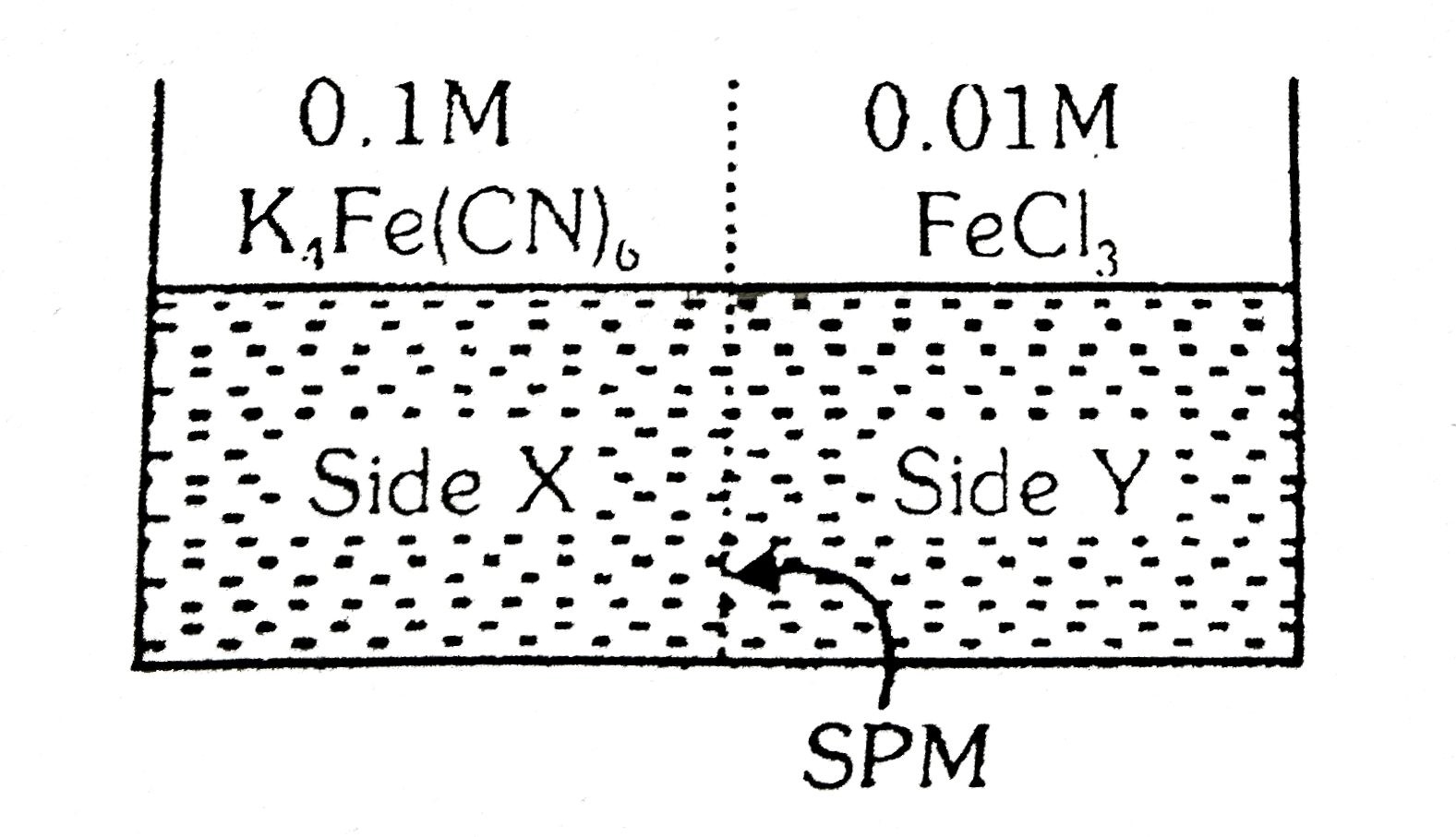ions give red colour with ions in aqueous solution as:
If solution is separated from solution by means of a semi-permeable membrane, red colour will appear on:
a. soluion , b. solution side ,
c. Both sides , d. Neither side
To solve the problem, we need to analyze the situation where a 0.1 M KCNS solution is separated from a 0.1 M FeCl₃ solution by a semi-permeable membrane. We are interested in determining where the red color will appear due to the formation of the Fe(CNS)₃ complex.
1. Understanding the Reaction:
The reaction between Fe³⁺ ions and CNS⁻ ions is given by:
Fe3+(aq)+3CNS−(aq)→Fe(CNS)3(aq)(red color)
This indicates that when Fe³⁺ ions react with CNS⁻ ions, they form a red-colored complex.
2. Concentration of Solutions:
We have two solutions:
- 0.1 M KCNS (which provides CNS⁻ ions)
- 0.1 M FeCl₃ (which provides Fe³⁺ ions)
3. Effective Concentration Calculation:
- For KCNS:
- KCNS dissociates into K⁺ and CNS⁻ ions.
- Thus, the effective concentration (C_effective) of ions from KCNS is:
Ceffective=0.1M×2=0.2M
- For FeCl₃:
- FeCl₃ dissociates into Fe³⁺ and 3 Cl⁻ ions.
- Thus, the effective concentration of ions from FeCl₃ is:
Ceffective=0.1M×4=0.4M
4. Comparison of Concentrations:
- The effective concentration of ions in the KCNS solution is 0.2 M.
- The effective concentration of ions in the FeCl₃ solution is 0.4 M.
- Since the effective concentration of FeCl₃ is higher than that of KCNS, the movement of solvent (osmosis) will occur from the KCNS side (lower concentration) to the FeCl₃ side (higher concentration).
5. Formation of Red Color:
- The red color will only appear where Fe³⁺ ions and CNS⁻ ions can react.
- Since the CNS⁻ ions are on the KCNS side and the Fe³⁺ ions are on the FeCl₃ side, the reaction can only occur on the FeCl₃ side when CNS⁻ ions move across the membrane.
6. Conclusion:
- The red color will appear on the FeCl₃ solution side due to the formation of the Fe(CNS)₃ complex.
Final Answer:
a. FeCl₃ solution side
The reaction between Fe³⁺ ions and CNS⁻ ions is given by:
Fe3+(aq)+3CNS−(aq)→Fe(CNS)3(aq)(red color)
This indicates that when Fe³⁺ ions react with CNS⁻ ions, they form a red-colored complex.
We have two solutions:
- 0.1 M KCNS (which provides CNS⁻ ions)
- 0.1 M FeCl₃ (which provides Fe³⁺ ions)
- For KCNS:
- KCNS dissociates into K⁺ and CNS⁻ ions.
- Thus, the effective concentration (C_effective) of ions from KCNS is:
Ceffective=0.1M×2=0.2M
- For FeCl₃:
- FeCl₃ dissociates into Fe³⁺ and 3 Cl⁻ ions.
- Thus, the effective concentration of ions from FeCl₃ is:
Ceffective=0.1M×4=0.4M
- The effective concentration of ions in the KCNS solution is 0.2 M.
- The effective concentration of ions in the FeCl₃ solution is 0.4 M.
- Since the effective concentration of FeCl₃ is higher than that of KCNS, the movement of solvent (osmosis) will occur from the KCNS side (lower concentration) to the FeCl₃ side (higher concentration).
- The red color will only appear where Fe³⁺ ions and CNS⁻ ions can react.
- Since the CNS⁻ ions are on the KCNS side and the Fe³⁺ ions are on the FeCl₃ side, the reaction can only occur on the FeCl₃ side when CNS⁻ ions move across the membrane.
- The red color will appear on the FeCl₃ solution side due to the formation of the Fe(CNS)₃ complex.
a. FeCl₃ solution side
Topper's Solved these Questions
- SOLUTIONSBOOK - CENGAGE CHEMISTRY ENGLISHCHAPTER - SOLUTIONSEXERCISE - Exercises (Linked Comprehension)
58 Videos
- SOLUTIONSBOOK - CENGAGE CHEMISTRY ENGLISHCHAPTER - SOLUTIONSEXERCISE - Exercises (Multiple Correct)
25 Videos
- SOLUTIONSBOOK - CENGAGE CHEMISTRY ENGLISHCHAPTER - SOLUTIONSEXERCISE - Ex 2.3 (Objective)
9 Videos
- SOLID STATEBOOK - CENGAGE CHEMISTRY ENGLISHCHAPTER - SOLID STATEEXERCISE - Ex 1.2 (Objective)
9 Videos
- SURFACE CHEMISTRYBOOK - CENGAGE CHEMISTRY ENGLISHCHAPTER - SURFACE CHEMISTRYEXERCISE - Archives Subjective
2 Videos
Similar Questions
Knowledge Check
Which of the following salts is the most basic in aqueous solution?
(a)Al(CN)3
(b)CH3COOK
(c)FeCl3
(d)Pb(CH3COO)2AAl(CN)3BCH3COOKCFeCl3DPb(CH3COO)2If on adding FeCl3 solution to acidified Lassaigne solution, a blood red colouration is produced, it indicates the presence of
ASBNCN and SDS and Cl
FeCl3 on reaction with K4[Fe(CN)6] in aqueous solution gives blue colour. These are separated by a semi-permeable membrane AB as shown. Due to osmosis, there is

View SolutionFeCI3 on reaction with K4[Fe(CN)6] in aqueous solution gives blue colour.

These are separated by a semipermeable membrane AB as shown. Due to osmosis there is:
View SolutionFeCI3 on reaction with K4[Fe(CN)6] in aqueous solution gives blue colour.

These are separated by a semipermeable membrane AB as shown. Due to osmosis there is:
View SolutionExplain why :
A blood red colouration is obtained on addition of FeCl3to Lassaigne's solution when the compound contains both N and S.
View SolutionOn adding few drops of dilutie HCl or FeCl3 to freshly precipitated ferric hydroxide a red coloured colloidal solution is obtained. The phenomenon is know as
View SolutionThe sodium extract of an organic compound on treatment with FeSO4 solution, FeCl3 and HCl gives red solution. The red colour of
View Solution
